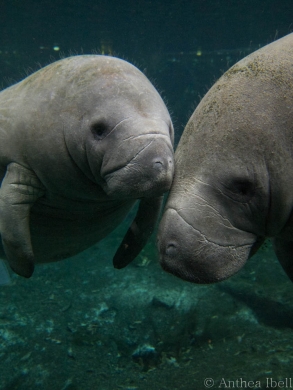Florida Manatees are widely dispersed in summer but migrate up streams and inlets in winter, when the sea surface temperatures cool. By following rivers inland, they are welcomed by the constant 72°F/21°C waters of freshwater springs. Crystal River, in Northern Florida hosts the largest aggregation of Manatees in winter months. I was able to visit Crystal River and snorkel with these beautiful barrel shaped mammals.
Boarding the small pontoon boat at 6am, we were greeted by a stunning sunrise, double rainbows and a manatee mother and calf. Slowly lowering ourselves into the silty water, our group then waited for them to find us, as the regulations state that we are not allowed to approach or follow any manatee. And then, out of the murky brown water a large, slow moving shape comes in to view. The upturned noses approach closer and closer and as we lay still on the surface, we expect them to brake. They just keep coming… both the mother and calf press their noses into swimmers, and in an attempt to get the attention that they like the most – a scratch on their belly – they roll over.
Some people may have qualms about this activity, arguing that petting wild animals isn’t a good way to interact. But I talked to various marine mammalogists at the Conference on the Biology of Marine Mammals, specifically sirenologist (those that study manatees and dugongs), and many said that the attention seeking and playful behaviour of the animals lends them quite nicely to human interaction and education.
With the help from research and observations, great regulations have been set in place for swimmer’s interactions with Florida manatees.
These include not approaching or following individuals, this way if they don’t want to play, they don’t have to; no duck diving while in the water, this limits the interaction to the surface; petting is only allowed with one open hand. And what I think is the most important is the instalment of ‘sanctuary’ areas. These are marked areas where swimmers and boats are not allowed, this gives the manatees a way to escape attention if need be, and to sleep soundly without interruptions from boats and snorkelers.
After a reasonable amount of time interacting with not only the mother and calf, but many other adult manatees that came out to play, we headed to Three Sisters Spring. Three Sisters was recently purchased by the ‘Save the Manatee Club’ with the help of local donations and federal funding. Save the Manatee Club has now installed a walking track and viewing platform for visitors to watch the manatees without getting into the water. Here, the spring’s clean flowing freshwater was crystal clear and swimming around the small lagoon there were numerous sleeping manatees, resting on the bottom. A small calf was getting bored and impatient as its mother slept soundly. After a few nudges the mother woke and took the young one for a lap around the lagoon then sunk back down to the bottom. These animals are incredibly beautiful and their behaviour makes them more so – the calf hugged the mother’s tail as she swum and at the end of the lap, mum stood up on her head, tail at the surface of the water, and the calf slid down her back. It was an incredible display to witness!
These manatees currently face many threats; namely pollution and injuries from boat strike. The sanctuaries and regulations mentioned are very
important, and the recent instalment of more ‘no wake zones’ and cameras along waterways will help to minimize harm to these incredible animals.
These animals are amusing and beautiful and it was a privilege to swim with them in the wild. Many thanks to Bird’s Underwater and the
Shephard family.







